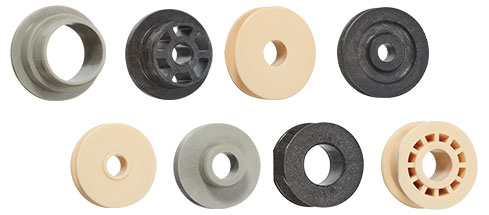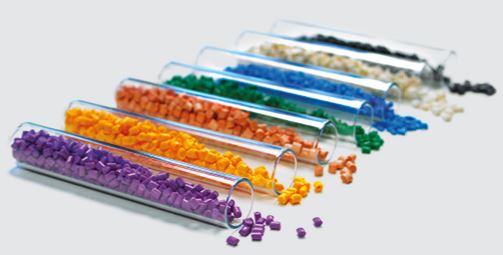Using plain bearings as rollers – A good idea?
Lars Butenschön | 5. February 2019
At first glance, many advantages of plain bearings sound attractive for use as roller. They use less space than roller bearings, require no additional lubrication (depending on their type) and do not suffer as much from dirt and cleaning agents. On top of that they weigh less and are cheaper. But as usual, devil is in the details. So let´s take a look at what these details are.

The main difference – what is turning where and around what?
Let´s first try to define what we see as a roller. Usually, a bearing is designed to be press fitted into a housing. Then, a rotating or pivoting shaft moves inside the bearing. We speak of a roller, when the bearing turns in itself around a fixed shaft ( which is then called an axle). So the whole turning thing is done on the outer diameter of the bearing. For example on a guide rail, a slot guide or other surfaces. Another version I encountered in real life is a mixture of both. A roller that slides occasionally on the outside and on the inside – Not a great combo.
Rolling or sliding? Or both?
So let´s imagine a typical roller scenario. A sliding door on a cabinet. The door has rollers fixed to it, which roll an a rail. So inside of the rollers we have small pins, that the rollers turn on. Now it would be great if the door can be moved back and forth as easily as possible. For that, the rollers need to roll. If however, they start skidding around, moving the door will be harder. That´s because the supporting area (the area the load is distributed on) of a roller is very small. Without getting into the physics behind this, there are a few tips that can help right off the bat:
- The outer diameter of the roller should be as big as possible, with the inner diameter being as small as possible
- Increase friction between outer diameter of the roller and running surface
- If the above mentioned tips don´t help: try using an elastomer bandage (for example: TPE)
Chosing the right material
Bearings are usually designed to support a certain one-directional load while also generating as low heat as possible through as low friction as possible. Roller requirements however, are a bit more complex. A bearing usually sits comfortably in a housing that helps supporting the load. A roller only has a very small contact area between the rolling surface and it´s outer diameter – resulting in high pressure. This is described in whats called “Hertz compression”. In a roller application, either Roller or ground may defor. No matter how hard the material is. The result: Flattening of the roller or dents in the rolling surface. To minimize the effect, fibres can be added to the plastic material.
Churning loads
 But it doesn´t end here. In addition to the above mentioned flattening, there are more forces at work within the material. Diagonal loads. By turning around the axle, the bearing material is exposed to a situation similar to flattening cookie dough. Imagine the roller being cut in and rolled out flat, resembling a layer of dough. If you now roll a shaft – like a pastry roller – over the dough, you will not only flatten it, but you will also distribute it over a larger area. a small “wave” of dough forms in front of the pastry roller. This effect is called churning in car tires and at igus. For plastics, these diagonal loads can be quite a challenge. Especially if they are optimized as bearing materials which usually means being filled with solid lubricants. That means it is important to find a good composition of stability enhancing fibres and solid lubricants (which are neccessary for low friction on the inner diameter of a roller).
But it doesn´t end here. In addition to the above mentioned flattening, there are more forces at work within the material. Diagonal loads. By turning around the axle, the bearing material is exposed to a situation similar to flattening cookie dough. Imagine the roller being cut in and rolled out flat, resembling a layer of dough. If you now roll a shaft – like a pastry roller – over the dough, you will not only flatten it, but you will also distribute it over a larger area. a small “wave” of dough forms in front of the pastry roller. This effect is called churning in car tires and at igus. For plastics, these diagonal loads can be quite a challenge. Especially if they are optimized as bearing materials which usually means being filled with solid lubricants. That means it is important to find a good composition of stability enhancing fibres and solid lubricants (which are neccessary for low friction on the inner diameter of a roller).
Trial and error
Real life and experience show, that no matter if rollers are made off conventional plastics or tribologically enhanced bearing materials – designing proper one-piece rollers is not an exact science. No matter if it´s size, geometry or material composition: Experience from real life applications and test-results are key. It is therefore a good idea to consult experienced manufacturers – and even better: to do tests in real. Of course you will get both – knowhow and test samples from igus :).
What is your experience with rollers as machine components, made from conventional or even tribologic optimized plastics? I´m looking forward to reading your comments!

